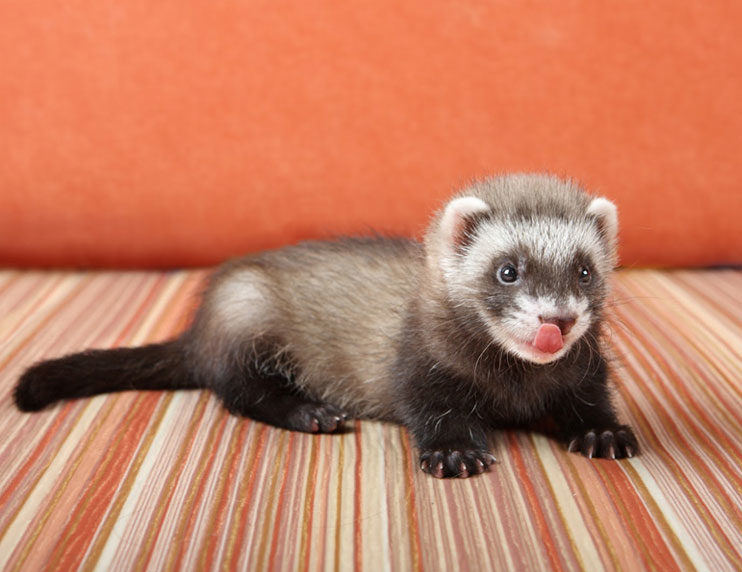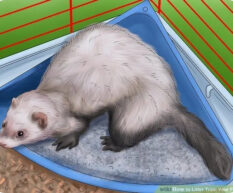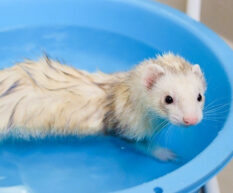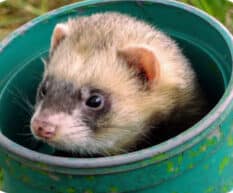Ferret News
How to Change Your Ferret’s Diet: Tips, Tricks, and Lots of Patience
By Dr. Rose-Anne Meissner, PhD

As a ferret owner, you may be on a mission to learn as much as you can about how to take care of your ferrets. The learning curve is steep, as ferrets are quite different from cats and dogs. If you didn’t grow up around ferrets, you may have a lot to learn in order to give them the good life that they deserve.
Diet is a topic of huge interest among ferrents. What a ferret eats will be the foundation of her health. And unlike other medical risk factors, such as genetics, diet is something you can control…sort of. Ferrets can be very picky and particular eaters. As young kits, they imprint by smell on the food they eat, so they have a very strong attachment to the foods they ate as youngsters. If you decide to change your ferret’s diet, the bad news is that it may be difficult. The good news is that there are a lot of tips and tricks you can try to coax them toward a different diet.
Why change your ferret’s diet?
Briefly, we wanted to touch on the most common reasons that motivate a change in diet. An in-depth discussion of these issues is beyond the scope of this article. If you haven’t already, check out Issue 20 of Dook Dook Ferret Magazine, which has several articles about ferret food and nutrition, including a detailed piece about ferret kibble and how to choose a high-quality kibble.
Medical reasons. Your ferret may develop a disease or an allergy that requires a change in diet to alleviate symptoms.
Nutritional upgrade. Many ferrents, upon learning about raw diets and the concept of an “ancestral diet,” want to switch their fuzzies to a meat-based diet instead of kibble. We the editors think that ferrets can thrive on raw meat or kibble diets. Our mission is to support you as you care for your ferrets, so we provide articles and data for both dietary approaches. (Also, see our article in Issue 20, “Understanding the calcium: phosphorus ratio in ferret diets,” to learn more about ferret ancestral diets.)
The preferred food is no longer available. A kibble brand may be recalled or a manufacturer may stop producing it. If this happens, you may have no choice but to figure out how to get your ferret to eat something else.
The most common advice for all dietary changes
There are two pieces of advice that show up repeatedly: go slowly and don’t give your ferrets access to their old food. Do you have to follow this advice no matter what?
Go slowly. This piece of advice was universal across all our sources. As you will see below, part of going slowly is the process of incorporating the new food into the old food to give your ferret a chance to acclimate to the new food’s smell, taste, and texture.
No access to old food! This advice was nearly universal. But we found one well-documented account in which the ferrent allowed her ferrets access to their old kibble at night. Sherry Stone hand-fed her ferrets their new food during the day. This approach ensured that they were trying their new food and gave her the confidence to graduate them to eating out of a common bowl.
One commonly cited concern about switching diets was insulinoma. Ferrets with insulinoma are likely to have problems with low blood sugar because of their disease. If a switch in diet causes them to not eat (or not eat enough), then that may exacerbate an already delicate health condition. If your ferret has insulinoma and you want or need to adjust their diet, we recommend doing it slowly and under a vet’s supervision.
Let’s talk about specific dietary changes! Note that even though some tips are listed under a single category, the tips here are largely interchangeable for any dietary switch.
Diet switch: from one type of kibble to another
Arguably, this is the easiest switch to make, but we make no promises that it will be easy! Because different kibbles are likely to have similar textures, your ferret may not object to his new food based on texture. But you will still have to cope with his reaction to different smells and flavors.
Dry kibble presents a unique opportunity for your ferret. A clever ferret who objects to the new food may actually remove it, piece by piece, from the old food. We have even seen stories of ferrets carrying the new food to their litterbox–a message that is loud and clear for their ferrents! If your ferret does this, you’ll want to try one or more of the “wet” methods for kibble.
- To slowly transition from one kibble to another, try combining the old kibble with the new in a ratio that slowly decreases the old and increases the new. If you planned a ten-day-long transition, you could start with 10% new food, 90% old food. Each day, increase the new food by 10% and decrease the old food by 10%. By day 10, you’ll be at 100% new kibble. You can always make the transition period longer if your ferret is less enthusiastic at first.
- To help the kibble smells mingle, mix together the old and new kibbles in a baggie and refrigerate it overnight.
- The “soup method.” We saw a lot of resources talk about this technique to help ferrets adjust to a new diet. Pour your kibble mixture onto a plate and mix a little water into it. Use a fork to mash it together. The goal is to make it hard for your ferret to pick out the old food from the new food.
- Try mixing a treat with your kibble combo, such as ferretone or salmon oil, to make it more appetizing.
Diet switch: from kibble to a raw diet
This is a huge topic of interest in the ferret community. If you are trying to make this switch, you are in good company!
- Consider a “soup” approach, whether with a straight raw food or raw mixed with kibble. You can mix a commercial raw food with water to make it soupy and then hand-feed it to your ferret. This method makes it easier to coax him to taste the new food because you can dab it on his nose.
- If your ferret begins to accept the raw food soup, you can begin to work your way up to larger pieces of meat, such as chicken wings.
Diet switch: from a raw diet to kibble
This switch is not one that seems very common in the ferret community. In doing the research for this article, I did not come across any examples of ferret owners switching from a raw diet to kibble. Assuming it does happen occasionally, I’d use the soup approach described above to begin incorporating kibble into the raw diet, slowly increasing the proportion of kibble over time.
Diet switch: upgrading a raw diet
As you learn more about ferret nutrition, you may decide to incorporate something new into an already-raw diet for your ferret. Maybe it’s adding more organ meat or bones into the mix, or a different type of meat. Our advice would be to add it into their current food slowly, in small amounts, to let your ferret adjust to a new flavor without turning them off of their food altogether. Try to add the new ingredient in a form that can’t be easily picked out of the food, by either chopping it up finely or blending it.
Take it slowly and don’t get discouraged!
For your ferret, having a new diet forced upon her is a very big deal. Remember, a ferret cannot understand why you are changing her diet. All she knows is whether something smells and tastes good (or not) to her. I think as adults, it’s easy for us to forget that the decisions we make for our pets are inscrutable to them. It’s on us to be as intuitive and compassionate with them as possible. As with all health decisions around your ferret’s care, it never hurts to talk to your vet and see what she can recommend. This is especially important if the dietary change is motivated by illness or declining health.
Good luck!
Further reading
“How to Switch a Ferret to Raw Food.” Ferret-farm.com. Published on 20 December 2015. https://www.ferret-farm.com/2015/12/switchingtoraw.html. Accessed 5 May 2020. (Web page)
Johnson-Delaney, Cathy. “Ferret Nutrition.” Veterinary Clinics of North America: Exotic Animal Practice, volume 17. Published in 2014. Pages 449-470. (Scholarly article)
Stone, Sherry. “Documenting a Raw Diet Switch.” Holistic Ferret Forum. https://holisticferretforum.com/natural-diet/the-switch/documenting-a-raw-diet-switch/. Accessed 5 May 2020. (Web page)
“Switching Kibbles for Your Ferret.” Ferret.org. https://www.ferret.org/pdfs/education/switching_kibbles.pdf. Accessed 5 May 2020. (Online PDF)




